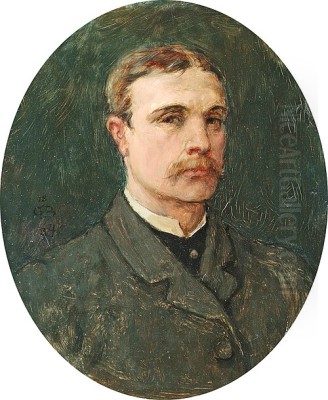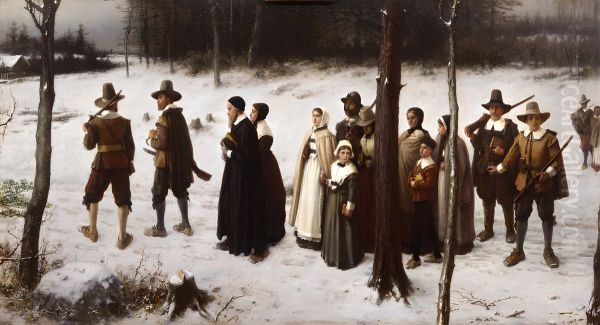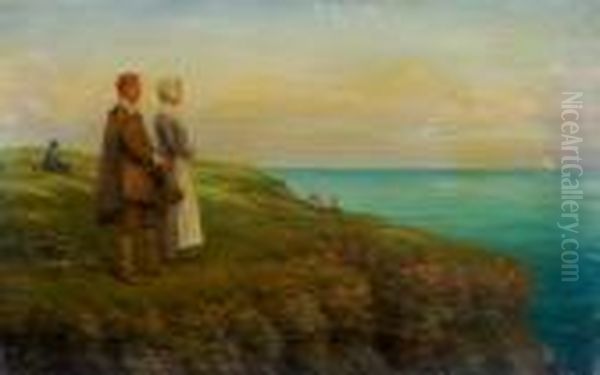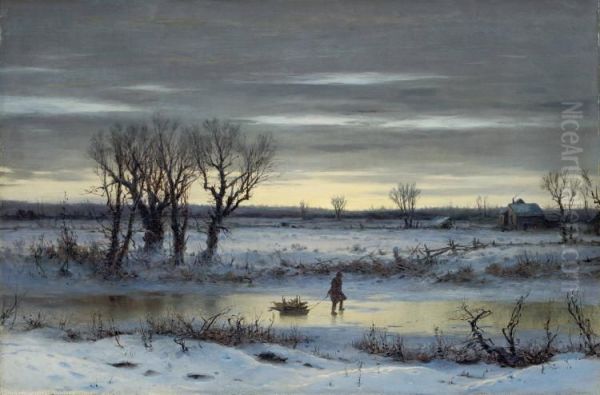
George Henry Boughton stands as a significant figure in nineteenth-century art, a painter whose life and career bridged the Atlantic, reflecting both his English birth and his American upbringing. Born in Norwich, England, in 1833, Boughton's destiny was intertwined with the New World from an early age when his family emigrated to Albany, New York, around 1835. This dual heritage would profoundly shape his artistic vision, allowing him to draw inspiration from both American and European traditions. Primarily known as a painter of genre scenes, landscapes, and historical subjects, Boughton also achieved recognition as an accomplished illustrator and writer, leaving behind a rich and varied body of work that continues to resonate today. His journey from a largely self-taught young artist in upstate New York to a respected member of the Royal Academy in London is a testament to his talent, ambition, and unique perspective.
Early Life and Artistic Beginnings
Boughton's formative years were spent in Albany, a city situated near the heartland of the burgeoning Hudson River School movement. Although not formally trained in his youth, he displayed a natural inclination towards art. Driven by an innate passion, he began teaching himself the fundamentals of drawing and painting. By the age of nineteen, his confidence and skill had grown sufficiently for him to open his own studio in Albany in 1852. This early period saw him absorbing the influences around him, likely including the romantic landscapes of artists associated with the Hudson River School, such as Thomas Cole and Asher B. Durand, whose works celebrated the sublime beauty of the American wilderness. Boughton's initial works focused primarily on landscape painting, capturing the scenery of New York State. His talent quickly gained local recognition, allowing him to sell enough work to finance his first significant trip abroad.

In 1853, Boughton embarked on a sketching tour of the British Isles, visiting England, Scotland, and Ireland. This journey was crucial, exposing him firsthand to the landscapes and artistic heritage of his native land. It provided him with fresh subject matter and broadened his artistic horizons beyond the American context. Upon returning to the United States, he continued to develop his craft, exhibiting his works in New York City. He showed paintings at the Washington Art Association in 1858 and gained further exposure at the National Academy of Design in 1859 and 1860, signaling his arrival on the wider American art scene. These early exhibitions helped establish his reputation as a promising young artist with a distinct sensibility.
European Studies and Developing Style
Seeking more formal training and exposure to contemporary European art, Boughton traveled to Paris in 1859 or 1860. This period was transformative for his artistic development. He sought out instruction from prominent French artists, notably Pierre-Édouard Frère and possibly Édouard May. Frère, known for his sentimental genre scenes of rural life, likely influenced Boughton's approach to narrative painting and his sympathetic portrayal of everyday people. The exposure to French art, including the emerging trends of Naturalism and the precursors to Impressionism, refined Boughton's technique. His palette may have lightened, and his brushwork perhaps gained a greater sensitivity to light and atmosphere under these influences. He spent time studying and sketching, absorbing the lessons of the French school, which emphasized careful observation and nuanced execution.
This European sojourn was not confined to France. Boughton also spent considerable time exploring Brittany, a region whose picturesque landscapes and traditional peasant life offered rich subject matter that resonated with his developing interest in genre painting. The experience gathered during these years abroad significantly shaped his mature style, blending his American sensibilities with a more sophisticated, European-influenced technique. He learned to combine narrative interest with atmospheric landscape settings, creating works that were both engaging and aesthetically pleasing. This fusion of influences would become a hallmark of his art.
Establishing a Reputation in America and England
After his studies in France, Boughton initially returned to the United States, but his gaze soon turned back towards Europe. Around 1861 or 1862, he made the decisive move to settle in London, which would remain his primary residence for the rest of his life. Despite living in England, he maintained strong ties to the American art world and frequently depicted American subjects, particularly those drawn from its colonial past. He continued to exhibit in both countries, successfully navigating the transatlantic art scene. His dual identity allowed him to offer a unique perspective, interpreting American history and literature for a British audience and bringing a European refinement to American themes.

His decision to move to London placed him at the center of the vibrant Victorian art world. He quickly integrated into artistic circles, finding success both commercially and critically. His paintings appealed to the Victorian taste for narrative, historical subjects, and sentiment. He became known for his carefully researched and meticulously rendered scenes, often imbued with a gentle melancholy or quiet dignity. His work stood apart for its blend of American subject matter and a style influenced by French and British contemporaries, such as Frederick Walker, whose idyllic rural scenes shared some affinities with Boughton's work.
Themes and Subjects: History, Landscape, and Literature
Boughton's oeuvre is characterized by its thematic diversity, yet certain subjects recur throughout his career. He is perhaps most famous for his depictions of early American colonial history, particularly the lives of the Pilgrim Fathers and Puritans in New England. These works tapped into a growing interest in America's origins and national identity during the latter half of the nineteenth century. His paintings offered romanticized yet evocative glimpses into the past, portraying the austerity, piety, and resilience of the early settlers. These historical genre scenes were praised for their atmospheric quality and emotional depth.
Beyond American history, Boughton was deeply drawn to the landscapes and folk life of other regions. His travels in Brittany provided inspiration for numerous paintings depicting peasant life against picturesque backdrops. Similarly, his time spent in Holland resulted in a significant body of work focused on Dutch landscapes, waterways, and traditional culture. These paintings often possess a tranquil beauty, characterized by silvery light and harmonious compositions. He was adept at capturing the specific atmosphere of a place, whether it be the windswept coast of New England, the rustic charm of Brittany, or the flat, canal-crossed landscapes of the Netherlands.
Literature also provided a rich source of inspiration for Boughton. He created memorable illustrations for classic works of American literature, bringing visual life to the characters and settings imagined by authors like Washington Irving and Nathaniel Hawthorne. His ability to translate literary themes into compelling visual narratives further demonstrated his versatility and imaginative power. Whether depicting historical events, capturing the essence of a landscape, or illustrating a beloved story, Boughton approached his subjects with sensitivity and skill.
Masterworks and Signature Style

Among Boughton's most celebrated works is Pilgrims Going to Church, also known as Early Puritans of New England Going to Church, painted in 1867. This iconic image depicts a group of stern-faced Puritans, armed and vigilant, making their way through a snowy woodland towards a distant church. The painting masterfully captures the harsh conditions and pious determination of the early settlers. Its somber palette, dominated by whites, grays, and blacks, evokes the austerity of their lives, while the figures' resolute expressions convey their unwavering faith. The work became immensely popular, particularly in the United States, where it was widely reproduced and became synonymous with the Thanksgiving holiday and the foundational myths of the nation. It is housed in the collection of the New York Historical Society.
Another significant later work is The Road to Camelot (1898). This painting showcases Boughton's engagement with literary themes, specifically the Arthurian legends popularized by Tennyson. It depicts figures, likely including Elaine, journeying through a luminous, dreamlike landscape towards the mythical castle. The painting is characterized by its ethereal atmosphere, delicate color harmonies, and romantic sensibility. It reflects the influence of late Pre-Raphaelitism and Aestheticism, demonstrating Boughton's ability to adapt his style to different subjects and contemporary artistic trends. This work highlights his skill in creating evocative moods and poetic visual narratives.
Boughton's signature style is often described as a blend of realism and romanticism. He paid close attention to detail, particularly in costume and setting, lending authenticity to his historical and genre scenes. However, his work transcends mere factual representation; it is imbued with sentiment, atmosphere, and a distinct narrative quality. His use of color was often subtle and refined, favoring harmonious palettes and soft, diffused light. He excelled at creating compositions that were balanced and visually engaging, drawing the viewer into the world he depicted. His figures, while sometimes idealized, possess a quiet dignity and emotional resonance.
Illustrative Work: Bringing Literature to Life
George Henry Boughton's talents extended beyond the canvas into the realm of illustration, where he made significant contributions. His work in this field is best exemplified by his illustrations for editions of Washington Irving's classic tales, Rip Van Winkle (published 1893) and A History of New York (also known as Knickerbocker's History of New York). For Rip Van Winkle, Boughton created evocative images that captured the folk-tale quality and gentle humor of Irving's story, depicting Rip's encounters in the Catskill Mountains and his bewildered return to a changed village. These illustrations helped solidify the visual iconography associated with the tale.
Similarly, his illustrations for Nathaniel Hawthorne's The Scarlet Letter demonstrated his ability to engage with complex literary themes. He provided visual interpretations of Hawthorne's exploration of sin, guilt, and redemption in Puritan Boston, capturing the somber atmosphere and psychological depth of the novel. Boughton's work also graced the pages of prominent periodicals like Harper's New Monthly Magazine, reaching a wide audience. His skill as an illustrator lay in his ability to complement the text without overwhelming it, creating images that were both artistically accomplished and narratively insightful. This aspect of his career cemented his reputation as a versatile artist adept at working across different media.
Furthermore, Boughton combined his literary and artistic skills by writing and illustrating his own book, Sketching Rambles in Holland (1885). Based on his travels, the book offered charming descriptions of Dutch life and scenery, accompanied by his own delightful drawings. This publication showcased his abilities not only as a visual artist but also as an engaging writer, providing personal insights into the places and people he encountered. His illustrative work, whether for his own writing or for classic literature, consistently displayed his characteristic sensitivity, attention to detail, and narrative flair.
Institutional Recognition and Social Circles
Boughton's artistic achievements earned him significant recognition from major art institutions on both sides of the Atlantic. In the United States, he was elected to the prestigious National Academy of Design in New York in 1871, confirming his standing within the American art establishment despite residing in London. His connection to American patrons remained strong; William T. Walters of Baltimore was a notable supporter who visited Boughton's studio, and his son Henry Walters also maintained contact, potentially facilitating connections with other artists like Lawrence Alma-Tadema.
In Britain, his adopted home, Boughton achieved even greater institutional success. He began exhibiting regularly at the Royal Academy in London soon after his arrival. His growing reputation led to his election as an Associate of the Royal Academy (ARA) in 1879. He was also active in watercolor painting and became an Associate of the Royal Institute of Painters in Water Colours in the same year (or the Royal Watercolour Society, sources vary slightly on the exact society and dates, but his involvement is clear). His ultimate recognition in Britain came in 1896 when he was elected a full Royal Academician (RA), joining the ranks of the most esteemed artists in the country, alongside figures like John Everett Millais and Frederic Leighton.
Beyond formal institutions, Boughton was an active participant in London's vibrant artistic and social life. He was a member of several prominent clubs, including the Arts Club, the Reform Club, the Athenaeum Club, and the Burlington Fine Arts Club. These memberships provided opportunities for networking, socializing, and exchanging ideas with fellow artists, writers, and intellectuals. He was known to be acquainted with James Abbott McNeill Whistler, another American expatriate artist in London, though their styles differed considerably. His London studio became a meeting place, and he moved within a circle that included narrative painters like Luke Fildes and others associated with the Royal Academy. His collaboration back in Albany with the sculptor Charles Calverley on stage scenery for the old museum there also points to his engagement with fellow artists across disciplines.
Dutch Influence and Travels
Holland held a particular fascination for George Henry Boughton, and his experiences there profoundly influenced his art and resulted in some of his most charming works. He made several trips to the Netherlands, drawn by its picturesque landscapes, unique quality of light, and the legacy of the Dutch Golden Age masters. He was captivated by the canals, windmills, traditional costumes, and the quiet rhythms of Dutch life. This interest culminated in his aforementioned book, Sketching Rambles in Holland (1885), which documented his travels and observations with both text and illustrations.
His paintings inspired by Holland often depict serene landscapes, tranquil canal scenes, or intimate glimpses of rural life. Works like The Dutch Ferry or Weeding the Pavement (held by the Tate, originally purchased by the Chantrey Bequest) exemplify his Dutch subjects. These paintings are characterized by their subtle color palettes, often featuring silvery grays, soft blues, and muted earth tones, reflecting the distinctive atmospheric light of the region. Boughton skillfully captured the flatness of the Dutch landscape and the interplay of water, sky, and land. His depictions of Dutch people are typically sympathetic and gently nostalgic, avoiding overt drama in favor of quiet observation. The influence of 17th-century Dutch masters like Jacob van Ruisdael or Meindert Hobbema can sometimes be discerned in his compositional structures and his sensitivity to atmospheric effects.
Later Career and Legacy
George Henry Boughton remained a productive artist throughout his later years, continuing to exhibit regularly at the Royal Academy and other venues. He maintained his studio in Campden Hill, London, which became a well-known fixture in the city's artistic landscape. While his historical scenes of early America remained popular, his later work also explored mythological and allegorical themes, as seen in The Road to Camelot. He continued to paint landscapes and genre scenes inspired by his travels in England, France, and Holland. His style, while evolving subtly over time, retained its core characteristics: narrative clarity, atmospheric sensitivity, and refined execution.
Boughton passed away in London in 1905. By the time of his death, he was a highly respected figure in the Anglo-American art world. His unique position as an artist who successfully navigated both British and American cultural contexts contributed significantly to his legacy. His works were acquired by major public collections in both countries, including the Tate Britain in London, the Metropolitan Museum of Art in New York, the National Gallery of Art in Washington D.C., the Albany Institute of History & Art, and the New York Historical Society. His paintings, particularly Pilgrims Going to Church, became enduring images within American popular culture.
Influence and Significance
George Henry Boughton's influence extended in several directions. His popularization of early American colonial subjects played a significant role in shaping the visual representation of that historical period for subsequent generations. His romanticized yet evocative depictions resonated with a public eager to connect with the nation's origins, influencing later artists who tackled similar themes. His work provided a visual touchstone for understanding the Puritan experience, however idealized.
Perhaps one of the most intriguing aspects of his influence is his connection to Vincent van Gogh. While serving as a lay preacher in England, Van Gogh delivered his first sermon in 1876. He later wrote to his brother Theo that the sermon was inspired by a print of a painting by Boughton, likely Pilgrims Going to Church or a similar work titled God Speed! Pilgrims Setting Out for Canterbury. Van Gogh admired the "unutterable charm" and sentiment of Boughton's work, finding in it a spiritual resonance that clearly moved him deeply. This connection highlights the emotional power and wide reach of Boughton's art, capable of inspiring one of the most revolutionary artists of the modern era.
Furthermore, Boughton's contributions to illustration helped elevate the status of the art form. His sensitive interpretations of literary classics demonstrated the potential for illustrations to be works of art in their own right, enriching the reader's experience and influencing subsequent illustrators. His career also exemplifies the fruitful cultural exchange that occurred between Britain and America during the nineteenth century. As an Anglo-American artist, he helped bridge the two art worlds, bringing American themes to London and European sophistication to American subjects. His ability to thrive in both contexts underscores the increasingly international nature of the art world in his time.
Conclusion
George Henry Boughton carved a unique path through the art worlds of the nineteenth century. Born an Englishman but raised an American, he synthesized influences from both cultures, creating a body of work characterized by narrative depth, atmospheric beauty, and technical refinement. From his early self-taught efforts in Albany to his esteemed position as a Royal Academician in London, his career was marked by consistent dedication and artistic exploration. He excelled in depicting historical narratives, particularly those of colonial America, leaving behind iconic images that became ingrained in the cultural consciousness. His landscapes captured the specific moods of England, Brittany, and Holland, while his illustrations brought classic literature to visual life. Remembered for his gentle romanticism, his skillful storytelling, and his ability to connect with audiences on both sides of the Atlantic, George Henry Boughton remains an important figure in the history of Anglo-American art. His legacy endures in his paintings and illustrations, which continue to offer evocative glimpses into the past and testament to a life lived in pursuit of artistic expression across two continents.